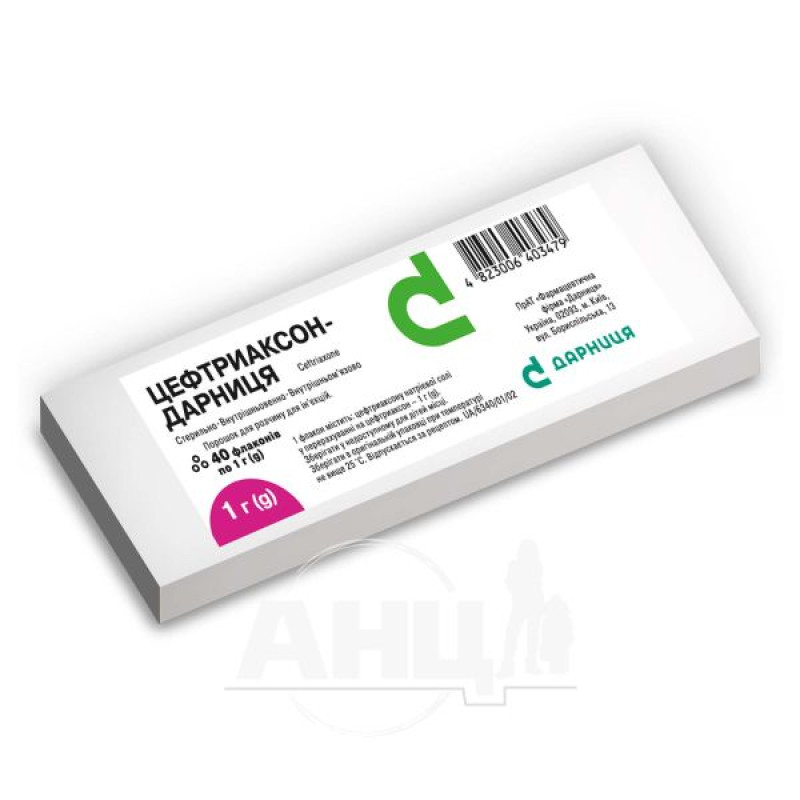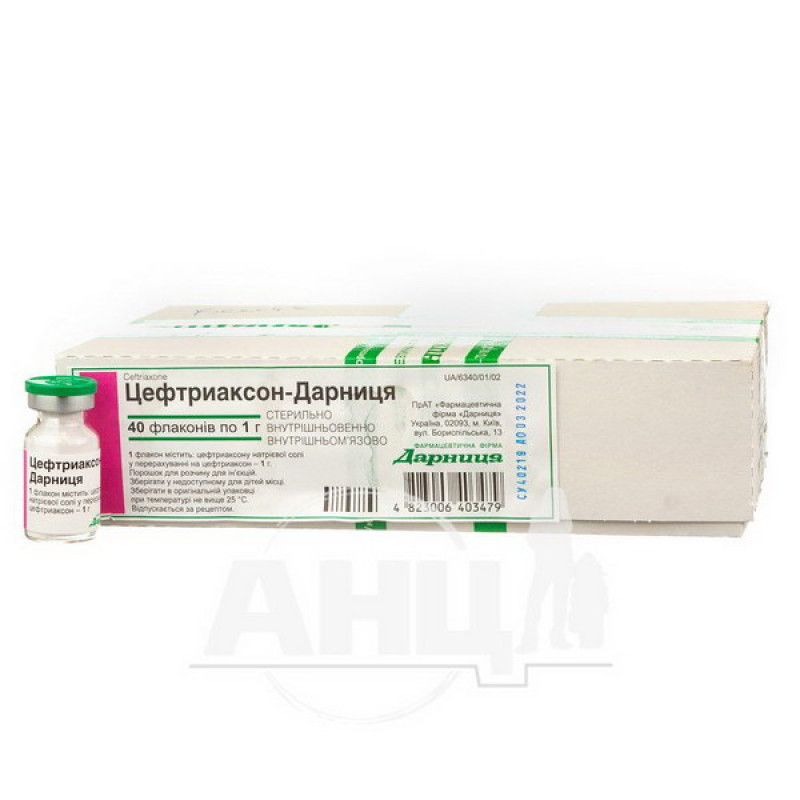Ceftriaxone-Darnitsa powder for solution for injection 1 g bottle No. 40

Ceftriaxone is a third-generation parenteral cephalosporin antibiotic with prolonged action.
Microbiology. The bactericidal activity of ceftriaxone is due to inhibition of cell membrane synthesis. Ceftriaxone is active in vitro against most gram-negative and gram-positive microorganisms. Ceftriaxone is characterized by very high resistance to most β-lactamases (both penicillinases and cephalosporinases) of gram-positive and gram-negative bacteria. Ceftriaxone is active against the following microorganisms in vitro and in clinical infections (see the "Indications" section):
Indications for use
Ceftriaxone-Darnitsa is used to treat infections whose pathogens are sensitive to ceftriaxone:
respiratory tract infections, especially pneumonia, as well as ear, throat and nose infections; abdominal infections (peritonitis, biliary tract and gastrointestinal tract infections); kidney and urinary tract infections; genital infections, including gonorrhea; sepsis; bone, joint, soft tissue, skin and wound infections; infections in patients with weakened immune systems; meningitis; disseminated Lyme disease (stages II and III).Perioperative prevention of infections during surgical interventions on the gastrointestinal tract, biliary tract, urinary tract and during gynecological procedures, but only in cases of potential or known contamination.
When prescribing the drug, it is necessary to follow official recommendations on antibiotic therapy and, in particular, recommendations on the prevention of antibiotic resistance.
Contraindication
Hypersensitivity to ceftriaxone or any other cephalosporin. History of severe hypersensitivity reactions (e.g. anaphylactic reactions) to any other type of β-lactam antibacterial agent (penicillins, monobactams and carbapenems).
Ceftriaxone is contraindicated:
Premature neonates ≤ 41 weeks of gestational age + postnatal age. In vitro studies have shown that ceftriaxone can displace bilirubin from serum albumin, leading to a possible risk of bilirubin encephalopathy in these patients.
Full-term newborns (aged ≤ 28 days):
with hyperbilirubinemia, jaundice, hypoalbuminemia, or acidosis, since in such conditions bilirubin binding is likely to be impaired.who require (or are expected to require) intravenous administration of calcium-containing medicinal products or infusions of calcium-containing solutions, as there is a risk of precipitation of ceftriaxone calcium salt (see sections “Special warnings and precautions for use” and “Adverse reactions”).
Before intramuscular administration of ceftriaxone, it is necessary to exclude the presence of contraindications to the use of lidocaine, if it is used as a solvent (see section "Special instructions for use"). See the instructions for use of lidocaine, especially contraindications.
Ceftriaxone solutions containing lidocaine should never be administered intravenously.
Method of administration and doses
Adults and children over 12 years of age: 1-2 g of ceftriaxone once daily (every 24 hours). In severe infections or infections where the pathogens are only moderately sensitive to ceftriaxone, the daily dose may be increased to 4 g.
Newborns, infants and children under 12 years of age.
Below are the recommended doses for once-daily use.
Newborns up to 2 weeks: 20-50 mg/kg body weight once a day, the daily dose should not exceed 50 mg/kg body weight. There are no differences in determining the dose of the drug for full-term and premature infants.
Ceftriaxone is contraindicated in neonates ≤ 28 days of age who require (or are expected to require) treatment with intravenous calcium-containing solutions, including continuous intravenous calcium-containing infusions, e.g. parenteral nutrition, due to the risk of precipitation of ceftriaxone calcium salts (see Contraindications).
Newborns and children from 15 days to 12 years: 20-80 mg/kg body weight once a day.
Children weighing more than 50 kg should be given adult doses.
Intravenous doses of 50 mg/kg or higher should be administered by infusion over at least 30 minutes.
Overdose
Symptoms: possible nausea, vomiting, diarrhea, fever, leukopenia, thrombocytopenia, acute hemolytic anemia, skin, gastrointestinal and liver reactions, shortness of breath, renal failure, stomatitis, anorexia, temporary hearing loss, loss of spatial orientation.
Treatment: symptomatic and supportive therapy. There is no specific antidote. Hemodialysis and peritoneal dialysis are ineffective.
Special instructions
Use during pregnancy or breastfeeding
Pregnancy.
Ceftriaxone crosses the placental barrier. There are limited data from the use of ceftriaxone in pregnant women. Animal studies do not indicate direct or indirect harmful effects with respect to embryonal/fetal, perinatal and postnatal development. Ceftriaxone should be used during pregnancy, especially in the first trimester, only if the benefit outweighs the risk.
Ceftriaxone is excreted in breast milk in low concentrations, but no effects on the breastfed infant are expected at therapeutic doses. However, the risk of diarrhoea and fungal infections of the mucous membranes cannot be excluded. The possibility of sensitization should be considered. A decision must be made whether to discontinue breast-feeding or to discontinue/abstain from ceftriaxone therapy taking into account the benefit of breast-feeding for the child and the benefit of therapy for the woman.
Fertility.
Reproductive studies have shown no evidence of adverse effects on male or female fertility.
Children
The medicine can be used in children according to the dosages specified in the section "Method of administration and doses".
The ability to influence the speed of reactions when driving vehicles or other mechanisms
No relevant studies have been conducted. Due to the possibility of side effects such as dizziness, ceftriaxone may affect the ability to drive or operate complex machinery.
Composition
active ingredient: ceftriaxone;
1 vial contains ceftriaxone sodium salt equivalent to ceftriaxone 1 g.
There are no excipients.
Storage conditions
Store in the original packaging at a temperature not exceeding 25 ° C. Keep out of the reach of children.
Shelf life - 3 years.
Incompatibility
Ceftriaxone-Darnitsa should not be mixed with calcium-containing solutions such as Ringer's solution or Hartmann's solution. Calcium solutions should also not be used within 48 hours after the last administration of the drug.
Ceftriaxone is incompatible with amsacrine, vancomycin, fluconazole, labetalol and aminoglycosides.
Do not mix with other solvents other than those listed in the "Method of administration and dosage" section.
There are no reviews for this product.
There are no reviews for this product, be the first to leave your review.
No questions about this product, be the first and ask your question.






